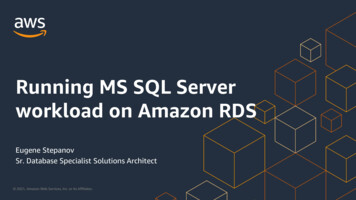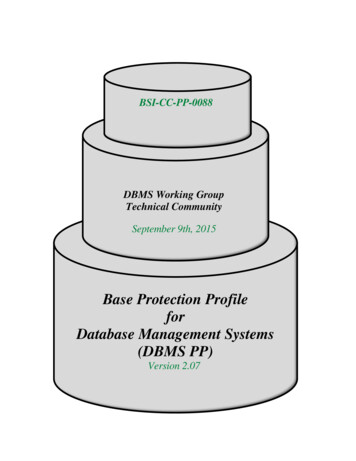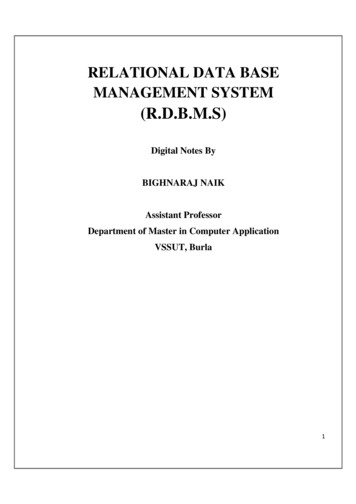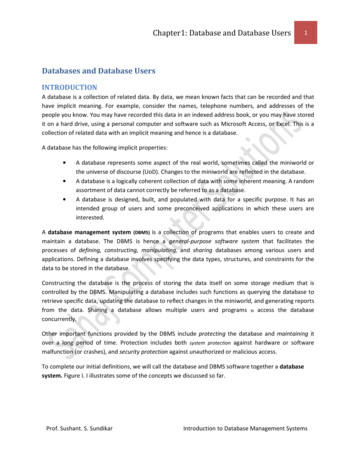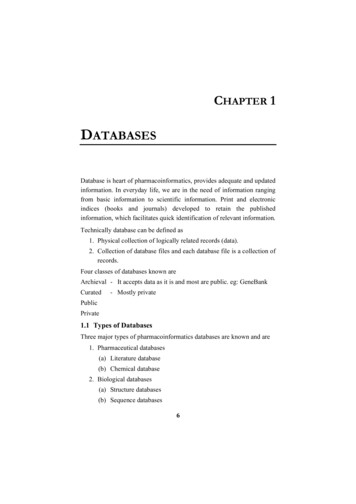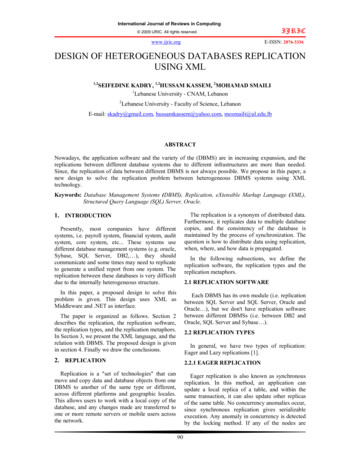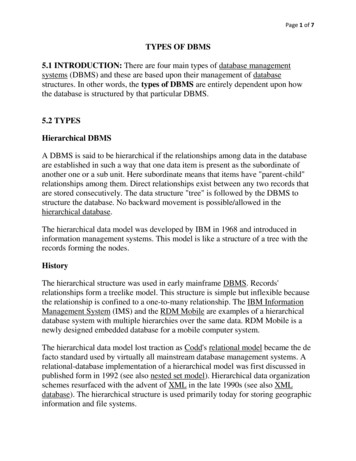
Transcription
Page 1 of 7TYPES OF DBMS5.1 INTRODUCTION: There are four main types of database managementsystems (DBMS) and these are based upon their management of databasestructures. In other words, the types of DBMS are entirely dependent upon howthe database is structured by that particular DBMS.5.2 TYPESHierarchical DBMSA DBMS is said to be hierarchical if the relationships among data in the databaseare established in such a way that one data item is present as the subordinate ofanother one or a sub unit. Here subordinate means that items have "parent-child"relationships among them. Direct relationships exist between any two records thatare stored consecutively. The data structure "tree" is followed by the DBMS tostructure the database. No backward movement is possible/allowed in thehierarchical database.The hierarchical data model was developed by IBM in 1968 and introduced ininformation management systems. This model is like a structure of a tree with therecords forming the nodes.HistoryThe hierarchical structure was used in early mainframe DBMS. Records'relationships form a treelike model. This structure is simple but inflexible becausethe relationship is confined to a one-to-many relationship. The IBM InformationManagement System (IMS) and the RDM Mobile are examples of a hierarchicaldatabase system with multiple hierarchies over the same data. RDM Mobile is anewly designed embedded database for a mobile computer system.The hierarchical data model lost traction as Codd's relational model became the defacto standard used by virtually all mainstream database management systems. Arelational-database implementation of a hierarchical model was first discussed inpublished form in 1992 (see also nested set model). Hierarchical data organizationschemes resurfaced with the advent of XML in the late 1990s (see also XMLdatabase). The hierarchical structure is used primarily today for storing geographicinformation and file systems.
Page 2 of 7Currently hierarchical databases are still widely used especially in applications thatrequire very high performance and availability such as banking andtelecommunications. One of the most widely used commercial hierarchicaldatabases is IMS. Another example of the use of hierarchical databases isWindows Registry in the Microsoft Windows operating systems.Examples of hierarchical data represented as relational tablesAn organization could store employee information in a table that containsattributes/columns such as employee number, first name, last name, andDepartment number. The organization provides each employee with computerhardware as needed, but computer equipment may only be used by the employee towhich it is assigned. The organization could store the computer hardwareinformation in a separate table that includes each part's serial number, type, and theemployee that uses it. The tables might look like this:In this model, the employee data table represents the "parent" part of the hierarchy,while the computer table represents the "child" part of the hierarchy. In contrast totree structures usually found in computer software algorithms, in this model thechildren point to the parents. Each employee may possess several pieces ofcomputer equipment, but each individual piece of computer equipment may haveonly one employee owner.In this, the "child" is the same type as the "parent". The hierarchy stating EmpNo10 is boss of 20, and 30 and 40 each report to 20 is represented by the "ReportsTo"column. In Relational database terms, the ReportsTo column is a foreign keyreferencing the EmpNo column. If the "child" data type were different, it would bein a different table, but there would still be a foreign key referencing the EmpNocolumn of the employees table.This simple model is commonly known as the adjacency list model, and wasintroduced by Dr. Edgar F. Codd after initial criticisms surfaced that the relationalmodel could not model hierarchical data.The Windows Registry is a hierarchical database that stores configuration settingsand options on Microsoft Windows operating systems.Network DBMSA DBMS is said to be a Network DBMS if the relationships among data in thedatabase are of type many-to-many. The many-to-many communication paradigm
Page 3 of 7is one of three major Internet computing paradigms, characterized by multipleusers contributing and receiving information, with the information elements ofteninterlinked across different websites. Developments such as file sharing, blogs,Wikis, and tagging are media forms that reflect this paradigm; these contrast withboth the one-to-one (characterized by e-mail, FTP, and Telnet) and one-to-many(characterized by websites) paradigms.With the evolution to the full "many-to-many" computing paradigm, people caninput and receive information to and from the Internet; they will be able to connectand communicate dynamically within a flexibly formed scope; there will be noartificial boundary between information and communication tools, and thedefinition of "many" will go well beyond people to include entities such asorganizations, products, processes, events, and concepts.The relationships among many-to-many appears in the form of a network. Thus thestructure of a network database is extremely complicated because of these manyto-many relationships in which one record can be used as a key of the entiredatabase. A network database is structured in the form of a graph that is also a datastructure. Though the structure of such a DBMS is highly complicated however ithas two basic elements i.e. records and sets to designate many-to-manyrelationships. Mainly high-level languages such as Pascal, C , COBOL andFORTRAN etc. were used to implement the records and set structures.OverviewWhile the hierarchical database model structures data as a tree of records, witheach record having one parent record and many children, the network model allowseach record to have multiple parent and child records, forming a generalized graphstructure. This property applies at two levels: the schema is a generalized graph ofrecord types connected by relationship types (called "set types" in CODASYL),and the database itself is a generalized graph of record occurrences connected byrelationships (CODASYL "sets"). Cycles are permitted at both levels. The chiefargument in favour of the network model, in comparison to the hierarchic model,was that it allowed a more natural modeling of relationships between entities.Although the model was widely implemented and used, it failed to becomedominant for two main reasons. Firstly, IBM chose to stick to the hierarchicalmodel with semi-network extensions in their established products such as IMS andDL/I. Secondly, it was eventually displaced by the relational model, which offereda higher-level, more declarative interface. Until the early 1980s the performancebenefits of the low-level navigational interfaces offered by hierarchical and
Page 4 of 7network databases were persuasive for many large-scale applications, but ashardware became faster, the extra productivity and flexibility of the relationalmodel led to the gradual obsolescence of the network model in corporate enterpriseusage.Database systemsSome well-known database systems that use the network model include: Integrated Data Store (IDS)IDMS (Integrated Database Management System)RDM EmbeddedRDM ServerTurboIMAGEUnivac DMS-1100HistoryThe network model's original inventor was Charles Bachman, and it was developedinto a standard specification published in 1969 by the Conference on Data SystemsLanguages (CODASYL) Consortium. This was followed by a second publicationin 1971, which became the basis for most implementations. Subsequent workcontinued into the early 1980s, culminating in an ISO specification, but this hadlittle influence on products.Relational DBMSA DBMS is said to be a Relational DBMS or RDBMS if the database relationshipsare treated in the form of a table. There are three keys on relational DBMS:relation, domain and attributes. A network means it contains a fundamentalconstructs sets or records sets contains one to many relationship, records containsfields statical table that is composed of rows and columns is used to organize thedatabase and its structure and is actually a two dimension array in the computermemory. A number of RDBMSs are available, some popular examples are Oracle,Sybase, Ingress, Informix, Microsoft SQL Server, and Microsoft Access.Object-oriented DBMSAble to handle many new data types, including graphics, photographs, audio, andvideo, object-oriented databases represent a significant advance over their otherdatabase cousins. Hierarchical and network databases are all designed to handle
Page 5 of 7structured data; that is, data that fits nicely into fields, rows, and columns. They areuseful for handling small snippets of information such as names, addresses, zipcodes, product numbers, and any kind of statistic or number you can think of. Onthe other hand, an object-oriented database can be used to store data from a varietyof media sources, such as photographs and text, and produce work, as output, in amultimedia format. Object-oriented databases use small, reusable chunks of software calledobjects. The objects themselves are stored in the object-oriented database.Each object consists of two elements: 1) a piece of data (e.g., sound, video,text, or graphics), and 2) the instructions, or software programs calledmethods, for what to do with the data. Part two of this definition requires alittle more explanation. The instructions contained within the object are usedto do something with the data in the object. For example, test scores wouldbe within the object as would the instructions for calculating average testscore. Object-oriented databases have two disadvantages. First, they are morecostly to develop. Second, most organizations are reluctant to abandon orconvert from those databases that they have already invested money indeveloping and implementing. However, the benefits to object-orienteddatabases are compelling. The ability to mix and match reusable objectsprovides incredible multimedia capability. Healthcare organizations, forexample, can store, track, and recall CAT scans, X-rays, electrocardiogramsand many other forms of crucial data.A relational database management system (RDBMS) is a database managementsystem (DBMS) that is based on the relational model as invented by E. F. Codd, ofIBM's San Jose Research Laboratory. Many popular databases currently in use arebased on the relational database model.RDBMSs have become a predominant choice for the storage of informationin new databases used for financial records, manufacturing and logisticalinformation, personnel data, and much more since the 1980s. Relationaldatabases have often replaced legacy hierarchical databases and networkdatabases because they are easier to understand and use. However, relationaldatabases have been challenged by object databases, which were introduced
Page 6 of 7in an attempt to address the object-relational impedance mismatch inrelational database, and XML databasesHistoryIn 1974, IBM began developing System R, a research project to develop aprototype RDBMS.[4] Its first commercial product was SQL/DS, released in1981.[5] However, the first commercially available RDBMS was Oracle, released in1979 by Relational Software, now Oracle Corporation.[6] Other examples of anRDBMS include DB2, SAP Sybase ASE, and Informix.Historical usage of the termThe term "relational database" was invented by E. F. Codd at IBM in 1970. Coddintroduced the term in his seminal paper "A Relational Model of Data for LargeShared Data Banks". In this paper and later papers, he defined what he meant by"relational". One well-known definition of what constitutes a relational databasesystem is composed of Codd's 12 rules. However, many of the earlyimplementations of the relational model did not conform to all of Codd's rules, sothe term gradually came to describe a broader class of database systems, which at aminimum: Present the data to the user as relations (a presentation in tabular form, i.e. asa collection of tables with each table consisting of a set of rows andcolumns);Provide relational operators to manipulate the data in tabular form.The first systems that were relatively faithful implementations of the relationalmodel were from the University of Michigan; Micro DBMS (1969), theMassachusetts Institute of Technology; (1971), and from IBM UK ScientificCentre at Peterlee; IS1 (1970–72) and its followon PRTV (1973–79). The firstsystem sold as an RDBMS was Multics Relational Data Store, first sold in 1978.Others have been Berkeley Ingres QUEL and IBM BS12.The most popular definition of an RDBMS is a product that presents a view of dataas a collection of rows and columns, even if it is not based strictly upon relationaltheory. By this definition, RDBMS products typically implement some but not allof Codd's 12 rules.
Page 7 of 7A second school of thought argues that if a database does not implement all ofCodd's rules (or the current understanding on the relational model, as expressed byChristopher J Date, Hugh Darwen and others), it is not relational. This view,shared by many theorists and other strict adherents to Codd's principles, woulddisqualify most DBMSs as not relational. For clarification, they often refer to someRDBMSs as Truly-Relational Database Management Systems (TRDBMS), namingothers Pseudo-Relational Database Management Systems (PRDBMS).As of 2009, most commercial relational DBMSes employ SQL as their querylanguage. Alternative query languages have been proposed and implemented,notably the pre-1996 implementation of Berkeley Ingres QUEL.
A relational database management system (RDBMS) is a database management system (DBMS) that is based on the relational model as invented by E. F. Codd, of IBM's San Jose Research Laboratory. Many popular databases currently in use are based on the relational database model. RDBMSs have become a predominant choice for the storage of information

